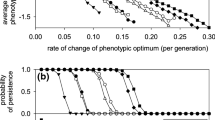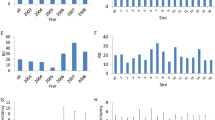Abstract
In life histories with generation overlap, selection that acts differently on different life-stages can produce reservoirs of genetic variation, for example, in long-lived iteroparous adults or long-lived dormant propagules. Such reservoirs provide “migration from the past” to the current population, and depending on the trend of environmental change, they have the potential either to slow adaptive evolution or accelerate it by re-introducing genotypes not affected by recent selection (e.g., through storage effect in a fluctuating environment). That is, the effect of generation overlap is a “double-edged sword,” with each edge cutting in a different direction. Here, we use sexual (quantitative trait) and asexual (clonal) models to explore the effects of generation overlap on adaptive evolution in a fluctuating environment, either with or without a trend in the mean environment state. Our analyses show that when environmental stochasticity scaled by strength of selection is intermediate and when the trend in mean environment is slow, intermediate values of generation overlap can maximize the rate of response to selection and minimize the adaptation lag between the trait mean and the environmental trend. Otherwise, increased generation overlap results in smaller selection response and larger adaptation lag. In the former case, low generation overlap results in low heritable trait variance, while high generation overlap increases the “migration load” from the past. Therefore, to understand the importance of rapid evolution and eco-evolutionary dynamics in the wild for organisms with overlapping generations, we need to understand the interaction of generation overlap, environmental stochasticity, and strength of selection.






Similar content being viewed by others
References
Abrams PA, Tucker CM, Gilbert B (2013) Evolution of the storage effect. Evolution 67:315–327
Alexander HK, Martin G, Martin OY, Bonhoeffer S (2014) Evolutionary rescue: linking theory for conservation and medicine. Evol Appl 7:1161–1179
Barfield M, Holt RD, Gomulkiewicz R (2011) Evolution in stage-structured populations. Am Nat 177:397–409
Barton NH, Etheridge AM, Véber A (2017) The infinitesimal model: definition, derivation, and implications. Theor Popul Biol 118:50–73
Baumgartner MF, Tarrant AM (2017) The physiology and ecology of diapause in marine copepods. Annu Rev Mar Sci 9:387–411
Bell G (2010) Fluctuating selection: the perpetual renewal of adaptation in variable environments. Phil Trans R Soc B 365:87–97
Bell G (2017) Evolutionary rescue. Annu Rev Ecol Evol Syst 48:605–627
Bolnick DI, Nosil P (2007) Natural selection in populations subject to a migration load. Evolution 61:2229–2243
Brendonck L, De Meester L (2003) Egg banks in freshwater zooplankton: evolutionary and ecological archives in the sediment. Hydrobiologia 491:65–84
Bridle JR, Polechová J, Kawata M, Butlin RK (2010) Why is adaptation prevented at ecological margins? New insights from individual-based simulations. Ecol Lett 13:485–494
Brown JS, Venable DL (1986) Evolutionary ecology of seed-bank annuals in temporally varying environments. Am Nat 127:31–47
Bruns TD, Peay KG, Boynton PJ, Grubisha LC, Hynson NA, Nguyen NH, Rosenstock NP (2009) Inoculum potential of Rhizopogon spores increases with time over the first 4 yr of a 99-yr spore burial experiment. New Phytol 181:463–470
Bulmer MG (1980) The Mathematical Theory of Quantitative Genetics. Clarendon Press, Oxford
Bürger R, Lynch M (1995) Evolution and extinction in a changing environment: a quantitative-genetic analysis. Evolution 49:151–163
Chevin L-M, Lande R, Mace GM (2010) Adaptation, plasticity, and extinction in a changing environment: towards a predictive theory. PLOS Biology 8:e1000357
Cohen D (1966) Optimizing reproduction in a randomly varying environment. J Theor Biol 12:119–129
Cohen D, Levin SA (1991) Dispersal in patchy environments: the effects of temporal and spatial structure. Theor Popul Biol 39:63–99
Dempster ER (1955) Maintenance of genetic heterogeneity. Pages 25–32 in Cold Spring Harbor Symposia on Quantitative Biology. Vol. 20. Cold Spring Harbor Laboratory Press
Doebeli M, Dieckmann U (2000) Evolutionary branching and sympatric speciation caused by different types of ecological interactions. Am Nat 156:S77–S101
Ellegaard M, Ribeiro S (2018) The long-term persistence of phytoplankton resting stages in aquatic ‘seed banks’. Biol Rev 93:166–183
Ellner S, Hairston NG Jr (1994) Role of overlapping generations in maintaining genetic variation in a fluctuating environment. Am Nat 143:403–417
Ellner S, Sasaki A (1996) Patterns of genetic polymorphism maintained by fluctuating selection with overlapping generations. Theor Popul Biol 50:31–65
Ellner SP, Hairston NG Jr, Kearns CM, Babaï D (1999) The roles of fluctuating selection and long-term diapause in microevolution of diapause timing in a freshwater copepod. Evolution 53:111–122
Evans MEK, Dennehy JJ (2005) Germ banking: bet-hedging and variable release from egg and seed dormancy. Q Rev Biol 80:431–451
Gomulkiewicz R, Holt RD (1995) When does evolution by natural selection prevent extinction? Evolution 49:201–207
Gyllström M, Hansson L-A (2004) Dormancy in freshwater zooplankton: induction, termination and the importance of benthic-pelagic coupling. Aquat Sci 66:274–295
Hairston NG Jr, De Stasio BT Jr (1988) Rate of evolution slowed by a dormant propagule pool. Nature 336:239–242
Hairston NG Jr, Ellner S, Kearns CM (1996a) Overlapping generations: the storage effect and the maintenance of biotic diversity. In: Rhodes OE Jr, Chesser RK, Smith MH (eds.) Population Dynamics in Ecological Space and Time. University of Chicago Press, Chicago, pp 109–145
Hairston NG Jr, Kearns CM, Ellner SP (1996b) Phenotypic variation in a zooplankton egg bank. Ecology 77:2382–2392
Haldane JBS, Jayakar SD (1963) Polymorphism due to selection of varying direction. J Genet 58:237–242
Hastings A (2004) Transients: the key to long-term ecological understanding? Trends Ecol Evol 19:39–45
Hedrick PW (1995) Genetic polymorphism in a temporally varying environment: effects of delayed germination or diapause. Heredity 75:164–170
Iwasa Y, Pomiankowski A, Nee S (1991) The evolution of costly mate preferences II. The “handicap” principle. Evolution 45:1431–1442
Kinnison MT, Hairston NG Jr (2007) Eco-evolutionary conservation biology: contemporary evolution and the dynamics of persistence. Funct Ecol 21:444–454
Kopp M, Matuszewski S (2014) Rapid evolution of quantitative traits: theoretical perspectives. Evol Appl 7:169–191
Lennon JT, Jones SE (2011) Microbial seed banks: the ecological and evolutionary implications of dormancy. Nat Rev Microbiol 9:119–130
Levin SA, Cohen D, Hastings A (1984) Dispersal strategies in patchy environments. Theor Popul Biol 26:165–191
Ludwig D, Levin SA (1991) Evolutionary stability of plant communities and the maintenance of multiple dispersal types. Theor Popul Biol 40:285–307
Lynch M, Lande R (1993) Evolution and extinction in response to environmental change. In: Kareiva PM, Kingsolver JG, Huey RB (eds.) Biotic Interactions and Global Change. Sinauer Associates Inc., Sunderland, pp 234–250
Messer PW, Ellner SP, Hairston NG Jr (2016) Can population genetics adapt to rapid evolution? Trends Genet 32:408–418
Miller ET, Klausmeier CA (2017) Evolutionary stability of coexistence due to the storage effect in a two-season model. Theor Ecol 10:91–103
Miner BE, De Meester L, Pfrender ME, Lampert W, Hairston NG Jr (2012) Linking genes to communities and ecosystems: Daphnia as an ecogenomic model. Proc R Soc B 279:1873–1882
Nuismer SL, Doebeli M, Browning D (2005) The coevolutionary dynamics of antagonistic interactions mediated by quantitative traits with evolving variances. Evolution 59:2073–2082
Orive ME, Barfield M, Fernandez C, Holt RD (2017) Effects of clonal reproduction on evolutionary lag and evolutionary rescue. Am Nat 190:469–490
Pantel JH, Duvivier C, De Meester L (2015) Rapid local adaptation mediates zooplankton community assembly in experimental mesocosms. Ecol Lett 18:992–1000
R Core Team (2017) R: a language and environment for statistical computing. R Foundation for Statistical Computing. Vienna, Austria
Rees M (1996) Evolutionary ecology of seed dormancy and seed size. Phil Trans R Soc B 351:1299–1308
Rees M, Ellner SP (in press) Why so variable: can genetic variance in flowering thresholds be maintained by fluctuating selection? Am Nat
Sasaki A, Ellner S (1997) Quantitative genetic variance maintained by fluctuating selection with overlapping generations: variance components and covariances. Evolution 51:682–696
Snyder RE, Adler PB (2011) Coexistence and coevolution in fluctuating environments: can the storage effect evolve? Am Nat 178:E76–E84
Templeton AR, Levin DA (1979) Evolutionary consequences of seed pools. Am Nat 114:232–249
Turelli M (2017) Fisher’s infinitesimal model: a story for the ages. Theor Popul Biol 118:46–49
Turelli M, Barton NH (1994) Genetic and statistical analyses of strong selection on polygenic traits: what, me normal? Genetics 138:913–941
Turelli M, Schemske DW, Bierzychudek P (2001) Stable two-allele polymorphisms maintained by fluctuating fitnesses and seed banks: protecting the blues in Linanthus parryae. Evolution 55:1283–1298
Walsh B, Lynch M (2018) Evolution and Selection of Quantitative Traits. Oxford University Press, Oxford
Acknowledgements
We thank two anonymous referees for detailed and helpful comments on the original manuscript.
Funding
M.Y. was supported by the Japan Society for the Promotion of Science (JSPS) Grant-in-Aid for Scientific Research (KAKENHI) 15H02642, 16K18618, 16H04846, and 18H02509 and by Hakubi Center for Advanced Research and John Mung Program of Kyoto University. N.G.H. was supported by USDA National Institute of Food and Agriculture, Hatch Grant 1007884, and by Eawag, the Swiss Federal Institute of Aquatic Science and Technology, while this paper was being prepared for publication. M.R. was supported by NERC-NE/K014048/1. S.P.E. was supported by US National Science Foundation grant DEB 1353039.
Author information
Authors and Affiliations
Corresponding author
Electronic supplementary material
Below is the link to the electronic supplementary material.
Rights and permissions
About this article
Cite this article
Yamamichi, M., Hairston, N.G., Rees, M. et al. Rapid evolution with generation overlap: the double-edged effect of dormancy. Theor Ecol 12, 179–195 (2019). https://doi.org/10.1007/s12080-019-0414-7
Received:
Accepted:
Published:
Issue Date:
DOI: https://doi.org/10.1007/s12080-019-0414-7




